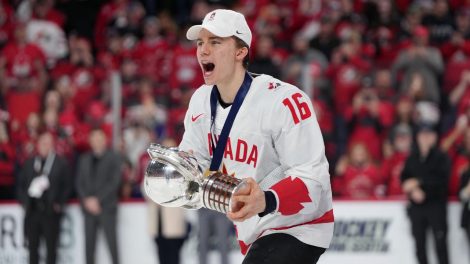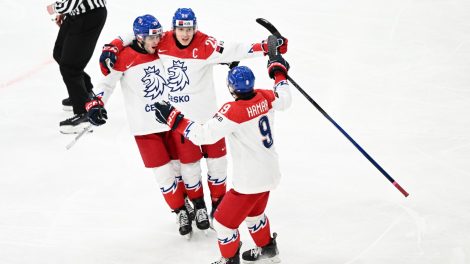Canada will play in the semifinals of the world junior tournament on Thursday and it has gotten this far with something approaching ease.
OK, the Canadian teens blew a two-goal third-period lead and lost in a shootout to the United States in a blizzard in the outdoor “classic.” And, yeah, if you’re going to nitpick, video reviews were just about the margin of victory over Finland. Still, Canada secured the top seed in Group A which gave it a quarter-final matchup against Switzerland, which was the nearest thing to a bye, a truth plain on its face as even the Swiss coach volunteered.
Questions hang out there with only two game days left in the tournament. Exactly what is this team? And whose team is it?
It says something about the lack of depth of talent in-tournament and Canada’s pretty favourable draw that, after five games, the team has yet to establish an identity. You don’t want to say that a bunch of teenagers who are on track for the NHL are nondescript, but teams in international play are measured not against their peers back in junior or the NCAAs so much as teams that have skated in this tournament before them, some with glory, others with disappointment.
Okay, start with the obvious. This edition of Canada isn’t up there with the group from 2005, when Sidney Crosby, Patrice Bergeron, Ryan Getzlaf, Corey Perry, Shea Weber and assorted others smoked the world in Grand Forks. I hope to still be drawing breath when Canada sends out another team comparable to that squad rife with future NHL all-stars and trophy winners. And really I don’t think a single player in the Canadian lineup in Buffalo is what you would call Hart, Art Ross, or Norris stuff.
That said, Canada has won tournaments with teams that have had a lot less elite talent than this one. Take 1997. Only half that team’s roster made the NHL and stuck. The one who really made his mark at the next level was Joe Thornton, who was a sparingly used 17-year-old. I’d lay down cash to bet that this tournament’s group will log more NHL games than did the ’97 squad, and if I’m wrong, you can collect in, oh, 20 years.
That said, looking at this lineup I’m left to wonder who, if anybody, projects to be a first-line player on a contender. Up front, Taylor Raddysh or Jordan Kyrou seem the most likely to but really I’d say that either one is no better than 50-50 to reach that level and that’s their ceiling.
The Canadians’ most valuable player in their thumping of Switzerland, defenceman Cale Makar, has been a bit of a revelation here. Makar had been off the public and media radar when he played for the Brooks Bandits in the Alberta Junior Hockey League and was a surprise selection of the Colorado Avalanche with the fourth-overall pick last June. And unless you subscribe to U Mass-Amherst’s video streaming, you haven’t seen him prior to this tournament. Is he a Norris candidate or all-star down the line? A big leap.
If someone could claim this team to be his own it’s probably goaltender Carter Hart, back for his second swing at the under-20s. He did just about everything you could ask of him in last year’s tournament. In the shootout loss to the U.S. in the final, he stood fairly alone out there. Maybe a near-brush with glory at the under-20s would have shaken another netminder but Hart has only built on it — he’s having an otherworldly season with Everett in the WHL this season (1.32 goals-against average and a staggering .961 save percentage).
Now, everyone knows that projecting goaltenders is a mug’s game. Who steps out of junior into a NHL role? The days of Tom Barrasso making a leap from high school to NHL all-star are long passed. Maybe Hart has a Vezina or, yeah, even a Hart in his future.
Listening to Canada’s captain Dillon Dube talk yesterday about his netminder would show that, at some level, consciously or not, team members look to Hart. Dube talked about Hart breaking the tension in the ranks between periods. Hart’s post-period routine (dare not call it a superstition) is to be the last player off the ice and a couple of times here in Buffalo backup goaltenders have used the pre-Zamboni interlude to elasticize their groins while Hart has stood by. Which of course is the source of no small amount of hilarity inside the pressure cooker that is the Canadian dressing room.
Over the years I’ve seen the pressure on the faces of more than a few Canadian kids but rare, nay unique, is the expression on Hart’s: The kid looked almost bemused by the attention he was receiving yesterday for his ritual (again, not a superstition).
“It’s what I do,” he said. “It’s part of my game, I guess. I’ve had one stand-off before in my life [before this tournament]. I don’t really care.”
In this case his actions tell a different story than his words, but no matter.
This year there’s no John Tavares, no Connor McDavid, no Your Superstar’s Name Here. Franchise goaltenders have passed through this program but when Carey Price won gold, the team was really Jonathan Toews’ more than the goalie’s, as good as the latter was.
Marc-Andre Fleury was the standout on a very average Canadian team that got to the gold-medal game in ’03 in Halifax and fell just short. That 1997 gold-medal-winning team had but one player on the tournament first all-star team: goaltender Marc Denis.
If Canada gets to the final, I could see something like that in the cards.
[relatedlinks]








